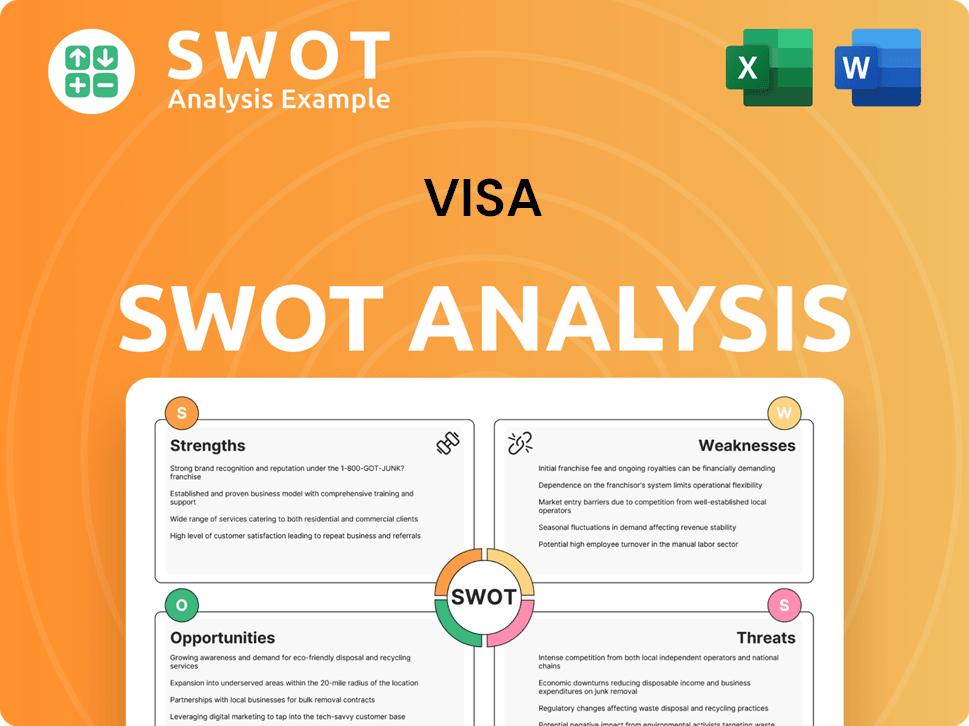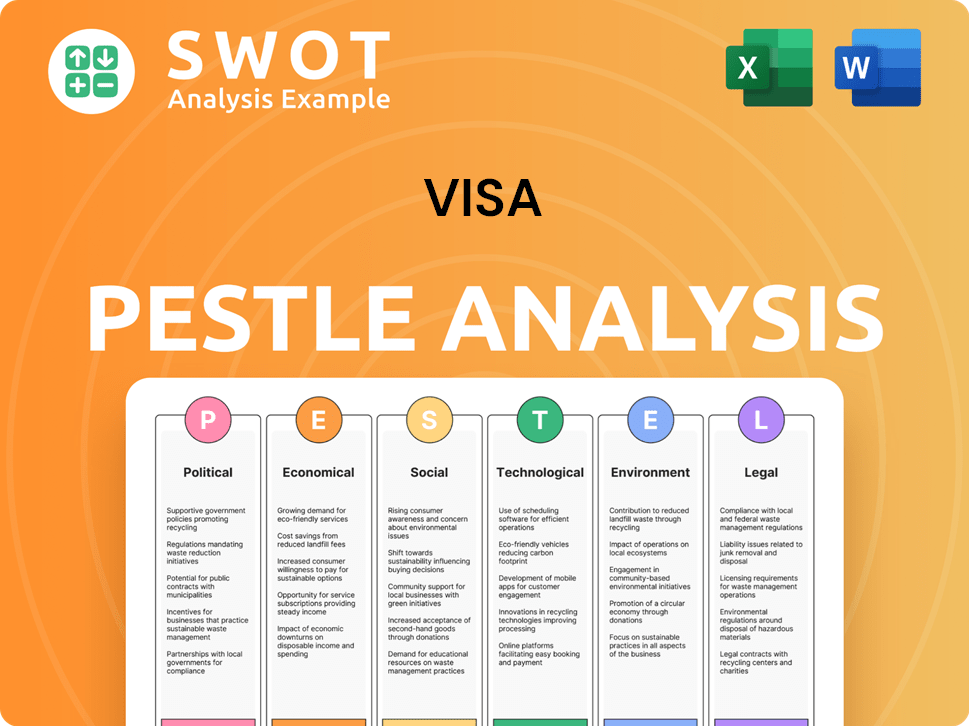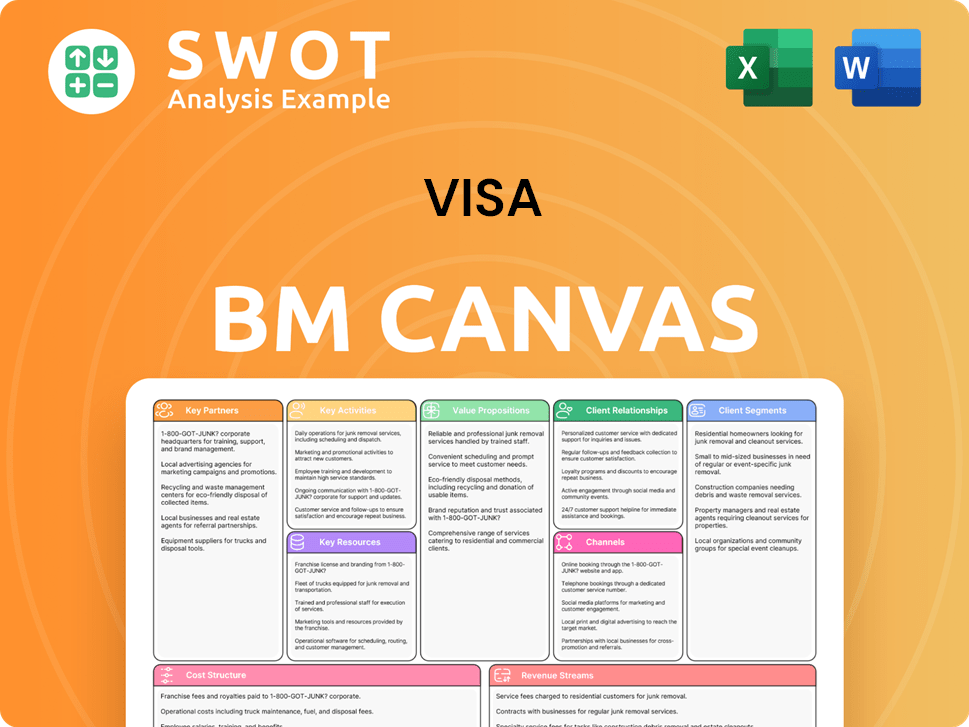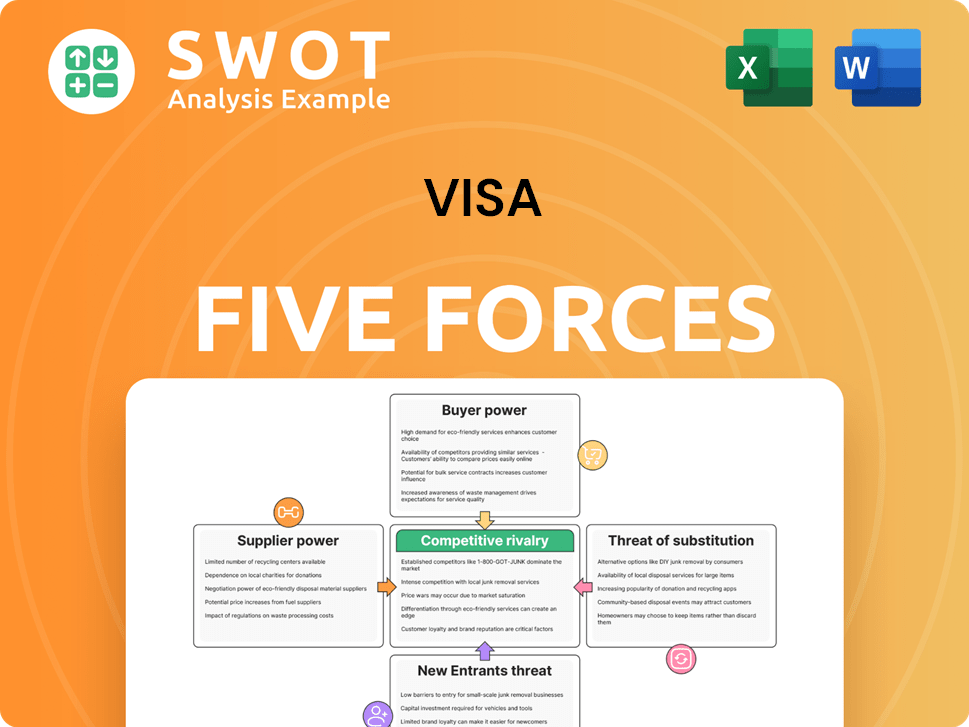Visa Bundle
How Does Visa Dominate the Payment Processing Industry?
Visa, a titan in the financial services sector, has revolutionized how we transact globally. From its humble beginnings in 1958 as BankAmericard, Visa has become synonymous with digital payments, connecting consumers and merchants worldwide. With a market capitalization consistently placing it among the top global brands, understanding Visa's competitive landscape is crucial for any investor or strategist.

This analysis delves into the Visa SWOT Analysis, exploring its key rivals and market position within the payment processing industry. We'll dissect Visa's strategies for market dominance, evaluating its competitive advantages and disadvantages, and comparing its market share against key Visa competitors like Mastercard. Furthermore, we'll examine how Visa navigates the evolving landscape of digital payments and fintech innovation, providing insights into its global presence and future prospects.
Where Does Visa’ Stand in the Current Market?
The core operations of Visa revolve around its global payment network, facilitating transactions between consumers, merchants, and financial institutions. This network processes payments using various products like Visa, Visa Debit, and Visa Electron. Visa's value proposition lies in providing a secure, reliable, and efficient platform for digital payments, offering convenience and global acceptance to its users.
In fiscal year 2024, Visa reported impressive financial results, with net revenues reaching $35.9 billion, a 10% increase from the previous year. The company's robust performance is further highlighted by a GAAP earnings per share of $9.73, which is up 17%. Visa's extensive network processed a staggering 234 billion total transactions, averaging 639 million transactions daily, demonstrating its significant role in the payment processing industry.
Visa's market position is strengthened by its widespread acceptance and technological advancements. The company's global payments volume increased by 8% year-over-year in constant dollars in Q4 2024, with international payments volume growing 10%. Cross-border volume, excluding intra-Europe, increased 13% on a constant-dollar basis for the three months ended September 30, 2024, showcasing its ability to facilitate international transactions efficiently. For a deeper understanding of who Visa serves, you can explore the Target Market of Visa.
Visa operates in over 200 countries and territories, offering a broad global presence. This extensive reach allows Visa to serve diverse customer segments, including consumers, merchants, financial institutions, and governments. Its global presence is a key factor in maintaining its competitive advantage within the Visa competitive landscape.
The company's financial health is robust, with a gross margin of 80% and a return on invested capital (ROIC) of 30% in Q2 FY25. These figures highlight Visa's ability to generate substantial cash flow and maintain profitability. Visa's revenue streams and profitability are key indicators of its market dominance.
Visa consistently adapts to technological advancements, such as the rise of digital payments. Tap-to-pay penetration reached 65% globally by the end of 2023, demonstrating its commitment to innovation. This continuous adaptation is crucial for Visa's strategies for market dominance.
Emerging markets represent significant expansion opportunities for Visa, particularly in regions where a large portion of the population remains underbanked. Expanding into these markets is key to Visa's long-term growth and competitive advantage. This expansion strategy addresses the challenges and opportunities within the financial services sector.
Visa's market position is defined by its substantial transaction volume and global reach. The company's ability to maintain high gross margins and ROIC reflects its operational efficiency and financial strength, which are vital in the Visa competitive landscape.
- Net revenues of $35.9 billion in fiscal year 2024.
- 234 billion total transactions processed in fiscal year 2024.
- Tap-to-pay penetration of 65% globally by the end of 2023.
- Cross-border volume growth of 13% in constant dollars (excluding intra-Europe) for the three months ended September 30, 2024.
Visa SWOT Analysis
- Complete SWOT Breakdown
- Fully Customizable
- Editable in Excel & Word
- Professional Formatting
- Investor-Ready Format

Who Are the Main Competitors Challenging Visa?
The competitive landscape of the payments industry is dynamic, with established players and emerging fintech companies constantly vying for market share. Understanding the key competitors is crucial for evaluating the strategic positioning and future prospects of any company within this sector. This analysis will explore the major players challenging Visa's dominance.
Visa faces competition from various sources, including traditional card networks, digital wallets, and innovative payment solutions. These competitors employ different strategies, from offering integrated services to leveraging technological advancements. The competitive environment necessitates continuous innovation and adaptation to maintain a leading position in the market.
The most significant direct competitor to Visa is Mastercard. Both companies operate global payment networks, but they compete on various fronts, including market share, transaction processing capabilities, and technological innovation.
Visa often maintains a slight edge in market share and revenue. From 2018 to 2022, Visa achieved an average Return on Invested Capital (ROIC) of 88% and a net profit margin of 48.5%. Mastercard's ROIC during the same period was 54% and its net profit margin was 41.3%.
Visa's transaction processing capacity is significantly higher. Visa can process around 65,000 transactions per second, while Mastercard processes approximately 5,000 transactions per second. This difference underscores Visa's technological infrastructure and scalability.
American Express and Discover are also direct competitors. They operate their own networks and offer integrated services, including card issuance and lending. These companies compete by providing a comprehensive suite of financial products and services.
Indirect competitors include digital wallets and alternative payment methods that are gaining popularity. These services often leverage existing card networks but offer simplified checkout experiences and integration with broader digital ecosystems.
Key indirect competitors include PayPal, Apple Pay, Google Pay, Stripe, and Block (Square). These companies offer various payment solutions, from digital wallets to payment processing for businesses. They are constantly innovating to capture market share.
The payment processing industry is evolving rapidly, with new players and technologies constantly reshaping the competitive landscape. 'Buy Now, Pay Later' (BNPL) services, open banking initiatives, and real-time payment networks are gaining momentum, presenting both challenges and opportunities for established companies like Visa.
- Voice-Activated Payments: This segment is projected to reach $164 billion by 2025, indicating a significant shift in consumer behavior and payment preferences.
- Mergers and Acquisitions: Visa completed the acquisition of Pismo in January 2024 to enhance its core banking and card-issuer processing capabilities, demonstrating its proactive approach to expanding its service offerings.
- Open Banking: Initiatives are also impacting the market, with the potential to disrupt traditional payment methods by enabling direct access to bank accounts for payments.
- Real-Time Payments: The increasing adoption of real-time payment networks is changing how transactions are processed, offering faster and more efficient payment solutions.
Visa PESTLE Analysis
- Covers All 6 PESTLE Categories
- No Research Needed – Save Hours of Work
- Built by Experts, Trusted by Consultants
- Instant Download, Ready to Use
- 100% Editable, Fully Customizable

What Gives Visa a Competitive Edge Over Its Rivals?
The competitive advantages of the company stem from its extensive global network, robust brand recognition, technological leadership, and substantial economies of scale. These factors collectively contribute to its strong position within the payment processing industry. The company's ability to maintain and enhance these advantages is crucial for its continued success in a rapidly evolving market.
The company's network effect is a key strength, with value increasing as more users and merchants join the ecosystem. This network, connecting consumers and businesses in over 200 countries and territories, provides reliable and fast transaction processing. The company's strategic partnerships with financial institutions also play a vital role in expanding its market reach and staying relevant in the face of new payment technologies.
Technological advancements and innovation are central to the company's strategy, particularly in digital payment solutions and cybersecurity. The company continuously invests in advanced fraud detection systems, utilizing algorithms and extensive data analysis to maintain a secure payment environment. The company's focus on innovation is evident in its development of new products, such as the Visa Flexible Credential.
The company's extensive network is a primary competitive advantage. This network connects consumers and businesses across over 200 countries and territories, ensuring high reliability and speed in transaction processing. The more users and merchants that join, the more valuable the network becomes.
The company's brand is widely recognized and trusted, which fosters customer loyalty. This trust translates into repeat business for merchants and provides a competitive edge in the financial services sector. The company's brand is a symbol of security and legitimacy.
The company excels in providing a high-performance and secure network, constantly investing in digital payment solutions and cybersecurity. The company uses advanced algorithms for fraud detection, enhancing security and consumer control over data. Innovation is key, as seen in the development of new products like the Visa Flexible Credential.
The company benefits from significant economies of scale, which allows it to offer competitive pricing and maintain higher profit margins. As transaction volumes increase globally, fixed costs are spread across a larger base. This cost leadership reinforces its market position.
The company's competitive advantages include its global network, strong brand equity, technological leadership, and economies of scale. These factors contribute to its market dominance and resilience against competitors. The company's ability to innovate and adapt to changing market dynamics is crucial for maintaining its competitive edge. For more insights, read about the Growth Strategy of Visa.
- Global Network: Spans over 200 countries and territories, providing unparalleled reach and reliability.
- Brand Recognition: Trusted by consumers and merchants globally, fostering loyalty and repeat business.
- Technological Innovation: Continuous investment in digital payment solutions, cybersecurity, and fraud detection.
- Economies of Scale: Efficient cost structure due to high transaction volumes, leading to competitive pricing.
Visa Business Model Canvas
- Complete 9-Block Business Model Canvas
- Effortlessly Communicate Your Business Strategy
- Investor-Ready BMC Format
- 100% Editable and Customizable
- Clear and Structured Layout

What Industry Trends Are Reshaping Visa’s Competitive Landscape?
The payments industry is experiencing a period of significant transformation, with technological advancements and evolving consumer preferences reshaping the competitive landscape for companies like Visa. This evolution presents both challenges and opportunities. Navigating these shifts effectively is crucial for maintaining and expanding market share in the face of increasing competition and regulatory scrutiny. Understanding the dynamics of the payment processing industry is key to success.
The future outlook for Visa involves adapting to new technologies, managing regulatory changes, and capitalizing on global growth opportunities. Strategic initiatives, such as investments in AI and partnerships, are critical for sustaining a competitive edge. The company's ability to innovate and respond to market changes will determine its long-term success in the financial services sector.
Technological advancements, including AI and blockchain, are key drivers in the payment processing industry. Voice-activated payments are projected to reach $164 billion by 2025. Digital wallets and 'Buy Now, Pay Later' (BNPL) services continue to gain traction, altering consumer payment behaviors.
Regulatory changes, such as the Credit Card Competition Act of 2023, pose challenges to the growth of credit card companies. Visa faces legal issues, including a lawsuit from the U.S. Justice Department. Interchange fees in the U.K. are also under scrutiny, potentially impacting revenue streams.
The global shift from cash to digital payments provides significant expansion opportunities, particularly in emerging markets. Cross-border e-commerce is growing, with Filipino consumers shopping on cross-border sites increasing. Product innovations like embedded finance are expected to handle $2.5 trillion in global transaction value by 2028.
Visa aims for low double-digit revenue growth in fiscal year 2025, driven by expanded partnerships and value-added services. The company is enhancing product design and innovation in consumer payments, targeting non-consumer payments, and returning capital to shareholders through a $30 billion share buyback program announced in April 2025.
Visa's competitive strategies focus on technology integration, partnerships, and global expansion to maintain its market dominance. These strategies are critical for navigating challenges and capitalizing on opportunities within the payment processing industry. Understanding Visa's brief history provides context to its evolution and current position.
- AI and Blockchain Integration: Leveraging these technologies for fraud detection and innovative solutions.
- Global Expansion: Targeting emerging markets and increasing cross-border e-commerce capabilities.
- Partnerships and Acquisitions: Forming strategic alliances, such as the acquisition of Pismo, to support new payment schemes.
- Product Innovation: Developing embedded finance solutions and account-to-account (A2A) payments.
Visa Porter's Five Forces Analysis
- Covers All 5 Competitive Forces in Detail
- Structured for Consultants, Students, and Founders
- 100% Editable in Microsoft Word & Excel
- Instant Digital Download – Use Immediately
- Compatible with Mac & PC – Fully Unlocked

Related Blogs
- What are Mission Vision & Core Values of Visa Company?
- What is Growth Strategy and Future Prospects of Visa Company?
- How Does Visa Company Work?
- What is Sales and Marketing Strategy of Visa Company?
- What is Brief History of Visa Company?
- Who Owns Visa Company?
- What is Customer Demographics and Target Market of Visa Company?
Disclaimer
All information, articles, and product details provided on this website are for general informational and educational purposes only. We do not claim any ownership over, nor do we intend to infringe upon, any trademarks, copyrights, logos, brand names, or other intellectual property mentioned or depicted on this site. Such intellectual property remains the property of its respective owners, and any references here are made solely for identification or informational purposes, without implying any affiliation, endorsement, or partnership.
We make no representations or warranties, express or implied, regarding the accuracy, completeness, or suitability of any content or products presented. Nothing on this website should be construed as legal, tax, investment, financial, medical, or other professional advice. In addition, no part of this site—including articles or product references—constitutes a solicitation, recommendation, endorsement, advertisement, or offer to buy or sell any securities, franchises, or other financial instruments, particularly in jurisdictions where such activity would be unlawful.
All content is of a general nature and may not address the specific circumstances of any individual or entity. It is not a substitute for professional advice or services. Any actions you take based on the information provided here are strictly at your own risk. You accept full responsibility for any decisions or outcomes arising from your use of this website and agree to release us from any liability in connection with your use of, or reliance upon, the content or products found herein.